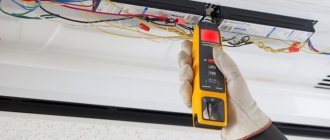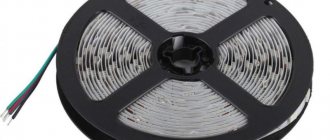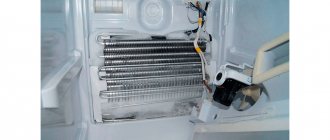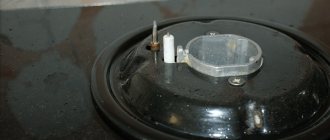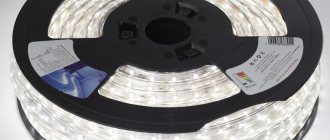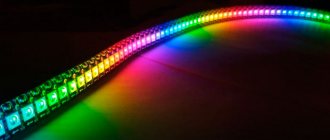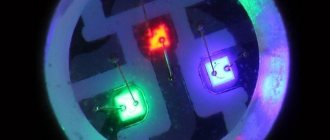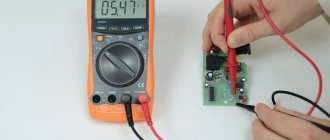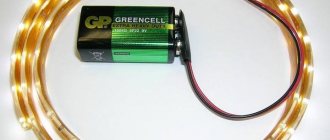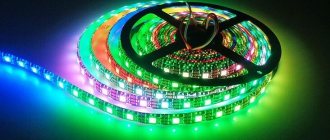What types of photo sensors are there?
Photosensors in various electronic devices, home and industrial automation devices, and various amateur radio designs .
Anyone who has ever disassembled an old computer mouse, as it was called a Komov mouse, with a ball inside, has probably seen wheels with slots spinning in the cracks of the photo sensors. Such photo sensors are called photointerrupters - they interrupt the flow of light. On one side of such a sensor there is a source - an LED, usually infrared (IR), on the other a phototransistor (to be more precise, two phototransistors, in some models a photodiode, to also determine the direction of rotation). When the wheel with slots rotates, electrical impulses are generated at the output of the photosensor, which is information about the angular position of this very wheel. Such devices are called encoders. Moreover, the encoder can simply be a contact one, remember the wheel on a modern mouse!
Photointerrupters are used not only in mice, but also in other devices, for example, speed sensors of any mechanism. In this case, a single photosensor is used, because the direction of rotation does not need to be determined.
If for some reason, most often for repair, one gets into other electronic devices, then photo sensors can be found in printers, scanners and copiers, in CD drives, in DVD players, video cassette recorders, video cameras and other equipment.
So what types of photo sensors are there, and what are they? Let’s just see, without delving into the physics of semiconductors, without understanding the formulas and without uttering incomprehensible words (recombination, resorption of minority carriers), what is called “on the fingers”, how these photosensors work.
Figure 1. Photointerrupter
Photoresistor
Everything is clear with him. Just like a regular constant resistor has an ohmic resistance, the direction of connection in the circuit does not matter. Only, unlike a constant resistor, the resistance changes under the influence of light: when illuminated, it decreases several times. The number of these “times” depends on the model of the photoresistor, primarily on its dark resistance.
Structurally, photoresistors are a metal case with a glass window, through which a grayish plate with a zigzag track is visible. Later models were made in a plastic case with a transparent top.
The speed of photoresistors is low, so they can only operate at very low frequencies. Therefore, they are almost never used in new developments. But it happens that in the process of repairing old equipment you will have to meet with them.
To check the health of the photoresistor, just check its resistance using a multimeter. In the absence of lighting, the resistance should be high, for example, the photoresistor SF3-1 has a dark resistance of 30 MOhm according to reference data. If you illuminate it, the resistance drops to several kOhms. The appearance of the photoresistor is shown in Figure 2.
Figure 2. Photoresistor SF3-1
Photodiodes
Very similar to a regular rectifier diode, if not for their ability to react to light. If you test it with a tester, preferably an outdated pointer tester, then in the absence of lighting the results will be the same as in the case of measuring a conventional diode: in the forward direction the device will show a small resistance, and in the reverse direction the needle of the device will hardly budge.
They say that the diode is turned on in the opposite direction (this point should be remembered), so no current flows through it. But, if in such a connection the photodiode is illuminated with a light bulb, the arrow will sharply rush to the zero mark. This mode of operation of the photodiode is called photodiode.
The photodiode also has a photovoltaic mode of operation: when light hits it, like a solar battery, it produces a weak voltage, which, if amplified, can be used as a useful signal. But, more often the photodiode is used in photodiode mode.
Photodiodes of the old design look like a metal cylinder with two terminals. On the other side there is a glass lens. Modern photodiodes have a housing simply made of transparent plastic, exactly the same as LEDs.
Rice. 2. Photodiodes
Phototransistors
In appearance they are simply indistinguishable from LEDs, the same case is made of transparent plastic or a cylinder with a piece of glass at the end, and there are two outputs from it - a collector and an emitter. The phototransistor does not seem to need a base output, because the input signal for it is the luminous flux.
Although, some phototransistors still have a base output, which allows, in addition to light, to control the transistor electrically. This can be found in some transistor optocouplers, for example AOT128 and imported 4N35 - essentially functional analogues. A resistor is connected between the base and emitter of the phototransistor to slightly cover the phototransistor, as shown in Figure 4.
Figure 3. Phototransistor
Our optocoupler usually has 10-100KOhm, but the imported “analogue” has about 1MOhm. If you put even 100KOhm, it will not work, the transistor is simply tightly closed.
How to test a phototransistor
It is quite easy to check a phototransistor with a tester, even if it does not have a base output. When the ohmmeter is connected in any polarity, the resistance of the collector-emitter section is quite large, since the transistor is closed. When light of sufficient intensity and spectrum hits the lens, the ohmmeter will show a small resistance - the transistor has opened, if, of course, it was possible to guess the polarity of the tester connection. In fact, this behavior resembles a regular transistor, only this one opens with an electrical signal, and this one with a light flux. In addition to the intensity of the light flux, its spectral composition plays a significant role. For details on testing transistors, see here.
Light spectrum
Typically, photo sensors are tuned to a specific wavelength of light. If this is infrared radiation, then such a sensor responds poorly to blue and green LEDs, but quite well to red, incandescent lamps and, of course, to infrared. It also does not perceive light from fluorescent lamps well. Therefore, the cause of poor performance of the photosensor may simply be an inappropriate spectrum of the light source.
It was written above how to ring a photodiode and phototransistor. Here you should pay attention to such a seemingly trifle as the type of measuring device. In a modern digital multimeter in semiconductor testing mode, the plus is located in the same place as when measuring DC voltage, i.e. on the red wire.
The result of the measurement will be the voltage drop in millivolts across the pn junction in the forward direction. As a rule, these are numbers in the range of 500 - 600, which depends not only on the type of semiconductor device, but also on the temperature. As the temperature increases, this figure decreases by 2 for every degree Celsius, which is due to the temperature coefficient of resistance of the TCS.
Determination using a multimeter
Before measuring the resistor, it is necessary to visually determine its integrity: inspect it for burnt outer coating - paint or varnish, and also check the inscriptions on the body, if they are visible. You can determine the denomination using tables of rows or color codes , after which you can measure the resistance using a multimeter.
For testing, you can use a simple measuring device, for example, DT-830B. First of all, you need to set the measurement switch to the minimum resistance test mode - 200 Ohms, and then connect the probes to each other. The device indicator with the probes connected should show the minimum value R, which tends to zero, for example, 0.03 Ohm. After the so-called calibration, you can begin measurements.
Checking the resistance on the board
Elements with an ohmic resistance of up to 200 Ohms must be tested in this measurement range. If the instrument readings indicate infinity, it is necessary to increase the measured range with a switch from 200 Ohms to 2000 Ohms (2 kOhms) and higher, depending on the rating being tested. Before checking a resistor with a multimeter without desoldering it, you need to:
- turn off the power source;
- unsolder one pin R, since due to the mixed connection of elements in the circuit there may be differences between the nominal value of the element and the readings of its actual value in the overall circuit during measurement;
- make a measurement.
Only low-resistance resistances can be ringed on the board, ranging from one ohm to tens of ohms. Starting from 100 Ohms and above, it becomes difficult to measure them, since the circuit may use radioelements that have a lower resistance than the resistor itself.
In addition to fixed resistors, there are the following types of elements:
- variable (rheostat);
- tuning;
- thermistor or negative temperature coefficient thermistor;
- posistor with positive temperature coefficient;
- The varistor changes its values depending on the voltage applied to it;
- the photoresistor changes its values depending on the light flux directed at it.
Checking the resistor with a multimeter to measure the performance of variables and trimming elements is carried out by connecting to the middle terminal of one of the probes, to any of the extreme terminals of the second probe. It is necessary to adjust the slider of the measured element in one direction all the way and back, and the reading of the device should change from the minimum to the nominal or actual resistance of the resistor. Similarly, you need to measure with the second extreme terminal of the potentiometer.
To check a posistor with a multimeter, you need to connect the measuring device to the terminals and bring it closer to the heat source. The resistance should increase depending on the temperature applied to it. Those who work with electronics know how to test a thermistor with a multimeter. Before this, you need to take into account that when it is exposed to the temperature of a heated soldering iron, its thermal resistance should decrease. Before checking the thermistor and posistor on the board, you need to unsolder one of the pins and then take a measurement.
Thermistors can operate at both high and low temperatures. PTC resistors and thermistors are used where it is necessary to control temperature, for example in electronic thermometers, temperature sensors and other devices.
Thermistors in the circuit are used as temperature stabilizers of cascades in power amplifiers or power supplies to protect against overheating. The thermistor can look like a bead with two wires, or it can be shaped like a plate with two leads.
How to determine the health of SMD resistors
SMD resistors are surface-mount components, the main difference of which is the absence of holes in the board. The components are installed on the current-carrying contacts of the printed circuit board. The advantage of SMD components is their small dimensions , which makes it possible to reduce the weight and size of printed circuit boards.
Testing SMD resistors with a multimeter becomes more difficult due to the small size of the components and their labels. The resistance value on SMD components is indicated as a code in special tables, for example, the designation 100 or 10R0 corresponds to 10 Ohms, 102 indicates 1 kOhm. Four-digit designations may occur, for example 7920, where 792 is the value and 0 is the multiplier, which corresponds to 792 ohms.
A simple photo relay.
It can be used to backlight DVDs. There are two types of circuit. In one, the activation is activated by light, and in the other by darkness. When light shines on the photodiode, the transistor opens and LED No. 2 lights up. We adjust the sensitivity with a resistor. The photodiode can be used from a computer mouse. You can take any infrared LED. Due to its use, there will be no interference from light. Instead of LED No. 2 - any or several LEDs. You can even use a light bulb. Two diagrams are shown below:
DVDs do not always use a photodiode. It contains a microcircuit. If there is no photodiode, then you can use a photoresistor. And if this is not the case, then find old transistors of the MP42 or MP39 series, and grind the upper part of the housing with a file. You will get a window that will serve as a photodiode. It is sensitive enough for this application. You can also install an infrared diode from the TV remote control.
Write comments, additions to the article, maybe I missed something. Take a look at the site map, I will be glad if you find anything else useful on my site.
Photoresistor and Arduino
Photoresistors give you the ability to sense the intensity of light.
They are small, inexpensive, require little energy, are easy to use, and are practically not subject to wear.
It is because of this that they are often used in toys, gadgets and gadgets. Of course, DIY projects based on Arduino could not ignore these wonderful sensors.
Photoresistors are essentially resistors that change their resistance (measured in ohms) depending on how much light hits their sensing elements. As mentioned above, they are very cheap, come in different sizes and specifications, but most are not very accurate. Each photoresistor behaves slightly differently from the other, even if they are from the same batch from the manufacturer. Differences in readings can reach 50% or even more! So you shouldn’t count on precision measurements. They are mainly used to determine the general level of illumination in specific, “local” rather than “absolute” conditions.
Photoresistors are an excellent choice for solving problems like “is the environment dark or light”, “is there something in front of the sensor (that limits the flow of light)”, “which area has the maximum level of illumination”.
Application area
In the modern world, the scope of application of these radio components has been significantly expanded.
The use of various photoresistors operating in the visible spectrum is quite extensive. It can be:
- Automatic light switch systems.
- Counting devices.
- Web or paper break sensors.
- Intrusion sensors.
- In devices equipped with exposure meters. For example, such elements could be used in standard point-and-shoot cameras.
In themselves, they are only an element of complex photodetector devices, which, in addition to the photodetector, may include:
- integrated amplifier;
- a microcircuit responsible for automatic lighting adjustment;
- power circuit diagrams, supplemented by a cooling system based on Peltier elements.
All this variety of elements for photodetectors is contained in a small sealed housing.
If these devices operate in the IR range, their scope is slightly different. They are used as part of complex devices such as:
- flame detection sensors;
- non-contact temperature measurement systems;
- humidity level monitoring systems;
- used to detect carbon dioxide;
- in infrared gas analyzers;
- used in paper tape break sensors in printing houses or in the paper industry;
- in industrial electronics, connecting a photoresistor can be used to automatically count products that move along a conveyor belt.
Accordingly, based on the fact that such a resistor will be controlled, its parameters are calculated.
For an example of how this element is used in practice, let's look at the photo relay circuit that controls street lighting.
Automation of street lighting
Automatic devices that turn on street lighting are able to detect the presence/absence of sunlight.
Here is a typical implementation diagram for connecting a photoresistor to automatically activate a night lighting device.
In general terms, the principle of operation of the circuit.
With the onset of twilight and at night, the resistance of the LDR increases, which causes a decrease in the voltage across the variable resistor R2. Transistor VT1 is closed, and VT2 opens, thus supplying voltage to the relay that turns on the lamp.
This is a completely working photo relay circuit, but its main drawback is the lack of hysteresis. This causes the relay to briefly buzz during twilight hours when there are slight changes in illumination.
This electronic part helps monitor the ambient light level.
Sensors for other conditions
In the printing industry, designs using a special photoresistor monitor the breakage of a paper roll. They can also be used to count paper sheets on a conveyor belt.
Connecting a photoresistor to Arduino
Light sensors that can use photoresistors can be implemented with your own hands based on Arduino boards.
Such schemes are quite simple, there is no question of “where to get them”, since they are available in online stores, and their price does not scare away customers.
A homemade module makes it possible to control the light level and react to its changes.
Having such an Arduino board in hand, it is easy to implement projects such as:
- light sensor;
- to turn on/off the relay;
- starts engines and so on.
Here is a typical example of using a light detector based on an Arduino board.
Average technical characteristics of photoresistors
The specifications below are for photoresistors from the Adafruit store. These photoresistors have similar characteristics to the PDV-P8001. Almost all photoresistors have different technical characteristics, although they work very similarly. If the seller gives you a link to the datasheet of your photoresistor, check them out, and not what is stated below.
- Size: Round, 5mm (0.2″) in diameter (other photoresistors can be up to 12mm/0.4″ in diameter!).
- Price: About $1.00 at Adafruit.
- Resistance range: from 200 kOhm (dark) to 10 kOhm (light).
- Sensitivity Range: Sensing elements detect wavelengths ranging from 400 nm (purple) to 600 nm (orange).
- Power: any with voltage up to 100 V, use a current of about 1 mA on average (depending on the supply voltage).
Problems when using multiple sensors
If, when adding additional sensors, it turns out that the temperature is inconsistant, this means that the sensors overlap each other when reading information from different analog pins. This can be corrected by adding two readings with delays and displaying the first one.
Phototransistor gain
The operating range of a phototransistor directly depends on the intensity of its illumination, since the positive potential of the base depends on this.
The base current from the incident photons is amplified with a transistor gain that varies from several hundred to several thousand units. It should be noted that a phototransistor with a gain of 50 to 100 is more sensitive than a photodiode.
Additional signal amplification can be provided using a Darlington phototransistor. A Darlington phototransistor is a phototransistor whose output (emitter) is connected to the base of a second bipolar transistor. Schematic representation of a Darlington phototransistor:
Light level measurement
As we have already said, the resistance of the photoresistor changes depending on the lighting level. When it is dark, the resistance of the resistor increases to 10 megohms. As the light level increases, the resistance decreases. The graph below shows the approximate sensor resistance under different lighting conditions. Do not forget that the characteristics of each individual photoresistor will be slightly different, these characteristics reflect only the general trend.
Please note that the characteristic is not linear, but has a logarithmic character.
Photoresistors do not perceive the entire range of light waves. In most versions they are sensitive to light waves in the range between 700 nm (red) and 500 nm (green).
That is, an indication of the light wavelength range that corresponds to blue will not be as effective as an indication of the green/yellow range!
What is the unit of measurement "lux"?
Most datasheets use lux (lx) to indicate resistance at a certain light level. But what is this - lk? This is not a method we use to describe brightness, so it is tied directly to the sensor. Below is a correspondence table that was taken from Wikipedia.
The simplified test process is as follows:
1) connect the diode under test to the “General” and “Ω X 100” sockets of the ohmmeter (Fig. 2, a) and note the ohmmeter readings when illuminating the diode with a table lamp with a power of 60-100 W (the distance between the photodiode and the lamp cylinder is taken equal to 60-80 mm) and darkening it by covering the diode window with your finger;
2) swap the leads of the photodiode (Fig. 2, b) and again measure the resistance when darkening and illuminating the test sample.
Checking the photoresistor
The simplest method of testing your photoresistor is to connect a multimeter in resistance measurement mode to the two contacts of the sensor and track the change in output resistance when you cover the sensor with your palm, turn off the light in the room, etc. Since the resistance varies over large ranges, the automatic mode works well. If you don't have an automatic mode or it doesn't work correctly, try the 1 MΩ and 1 kΩ range.
Photoresistor connection
Since photoresistors are essentially resistance, they have no polarity. This means that you can connect their legs 'any way you like' and they will work!
Photoresistors are really unpretentious. You can solder them, install them on a breadboard, or use clips for connection. The only thing you should do is bend the 'legs' too often, as they can easily break off.
Using photoresistors
Analog voltage reading method
The simplest use case is to connect one leg to the power source, the other to ground through a pull-down resistor. After this, the point between the fixed resistor and the variable resistor - the photoresistor - is connected to the analog input of the microcontroller. The figure below shows the connection diagram to Arduino.
In this example, a 5V power supply is connected, but remember that you can just as easily use a 3.3V supply. In this case, the analog voltage values will be in the range from 0 to 5V, that is, approximately equal to the supply voltage.
It works as follows: as the resistance of the photoresistor decreases, the total resistance of the photoresistor and the step-down resistor decreases from 600 kOhm to 10 kOhm. This means that the current passing through both resistors increases, which causes the voltage across the 10k resistor to increase. That's all!
This table provides approximate analog voltage values based on light level/resistance when connecting a 5V supply and a 10k ohm pull-down resistor.
If you want to use the sensor in a brightly lit area and use a 10k ohm resistor, it will quickly blow away. That is, it will almost instantly reach the permissible voltage level of 5 V and will not be able to distinguish between more intense lighting. In this case, you should replace the 10k ohm resistor with a 1k ohm resistor. With this circuit, the resistor will not be able to detect the level of darkness, but it is better to determine the shades of a high level of illumination. In general, you should play around with this depending on your conditions!
Additionally, you will also be able to use the "Axel Benz" formula to basicly measure the minimum and maximum resistance value using a multimeter and then find the resistor value using: Pull Resistor = Square Root(Rmin * Rmax), which will give you a much better result result in the form:
The table above shows approximate analog voltages when using a 5V sensor with a 1K pull-down resistor.
Don't forget that our method does not give us a linear dependence of voltage on illumination! In addition, each sensor has different characteristics. As the light level increases, the analog voltage will rise and the resistance will fall:
Vo = Vcc(R/(R+Photocell))
That is, the voltage is inversely proportional to the resistance of the photoresistor, which, in turn, is inversely proportional to the lighting level.
The principle of operation of a phototransistor
A typical transistor consists of a collector, emitter and base. In phototransistor operation, typically the base terminal remains disconnected as light generates an electrical signal allowing current to flow through the phototransistor.
When the base is turned off, the collector junction of the phototransistor is reverse biased, and the emitter junction is forward biased. The phototransistor remains inactive until light hits the base. Light activates the phototransistor, producing electrons and conduction holes - charge carriers, resulting in electric current flowing through the collector - emitter.
Simple code for analog light level measurements
The sketch does not perform any calculations, only displaying values that are interpreted as lighting levels. For many projects this is quite enough.
/* A simple test sketch for a photoresistor.
Connect one leg of the photoresistor to 5 V, the other to the Analog 0 pin.
After that, connect the pin of the 10 kOhm resistor to ground, and the second one to the analog pin Analog 0 */
int photocellPin = 0; // sensor and 10 kOhm pull-down resistor connected to a0
int photocellReading; // data read from the analog pin
// Transfer information for debugging to the serial monitor
Serial.print(photocellReading); // analog values
> else if (photocellReading
> else if (photocellReading
> else if (photocellReading
Serial.println(" - Very bright");
This test was carried out in a room during the day. I covered the sensor with my hand, and then with a piece of cloth.
Reading values from a photoresistor without using analog pins
Reading values from a photoresistor without using analog pins
Since photoresistors are essentially just resistors, they can be used even if your microcontroller has no analog pins (or if all the analog pins are occupied). This method is based on the basic properties of resistors and capacitors. If you take a capacitor that can transfer potential and connect it to a power source (eg 5V) through a resistor, the change in voltage will occur gradually. The higher the resistance of the resistor, the slower the voltage will change.
Below is a piece of the oscillogram that characterizes what exactly is happening with the digital pin (yellow). The blue line shows when the Arduino sketch itself begins to work and when it finishes its work (a section lasting about 1.2 ms).
If we draw simple analogies, the capacitor acts as a basket, and the resistor acts as a tube. Filling the basket with a thin tube will take a long time. Depending on the thickness of the tube, the filling speed of the basket will vary.
In our case, the 'basket' is a ceramic resistor with a capacity of 0.1 µF. You can experiment with the capacitance of the capacitor. And this indicator will directly affect the time. If you want to measure the light level, use a 1 µF capacitor. If you work in low light conditions, you can use a 0.01 uF capacitor.
/* a simple sketch to check the functionality of a photoresistor.
Connect one leg of the photoresistor to the power supply, the other to pin 2.
After this, connect one leg of the 0.1 uF capacitor to pin 2, and the other to ground */
int photocellPin = 2; // photoresistor connected to pin 2
int photocellReading; // digital values
int ledPin = 13; // you can use the built-in LED
// send information for debugging to be displayed in the serial monitor window
pinMode(ledPin, OUTPUT); // use LED as output signal
// read readings from the sensor using RCtime technology
if (photocellReading == 30000)
// if the reading reaches 30000, it means we have reached the limit value
Serial.println(photocellReading); // stream of read analog data
// the brighter, the more often the LED flashes!
// use digital pin to measure resistance
//we do this by applying current to the capacitor and
//calculating how long it will take to reach Vcc/2 (for most Arduinos this value is 2.5V)
int RCtime(int RCpin)
int reading = 0; // start from 0
// initialize the pin as output and assign it the value LOW (ground)
// Now set the pin as input and.
reading++; // increment for counting time
if (reading == 30000)
// if we get to this level, the resistance is so great
// that most likely nothing is connected!
break; // go outside the loop
Device
The shape of the case or the active layer changes from model to model, but one thing remains unchanged.
This is the base - a substrate made of ceramic material.
A thin layer of conductor made of gold or platinum is applied on the substrate in a snake-like manner by sputtering.
Various types of photoresist materials can also be used as semiconductors.
If you need to capture visible light with a long wavelength:
The most commonly used are cadmium selenide and cadmium sulfide.
To capture infrared radiation, plates can be made from:
- germanium in pure form or with the addition of small impurities;
- silicon;
- lead sulfide and other chemical combinations based on it.
In pure form, germanium or silicon is found in parts that have an internal photoelectric effect.
Other impurities can be used in devices with an external photoelectric effect.
The production of the first serial bismuth sulphide photoresistors in our country was established in 1948.
Later they were replaced by sulfur-cadmium and selenium-cadmium models, which showed much better parameters.
In any case, the properties remain the same.
The layers deposited in this way have leads to electrodes through which electric current flows.
From above, the entire structure is placed in a housing protected by a thin layer of transparent plastic, through which light fluxes enter.
The shape, size and material of the protective housing may vary. These parameters are determined by the manufacturer based on the purpose of the photoresistor and look different.
The design of a conventional photoresistor can be of different designs:
- in a metal case;
- in a plastic case;
- open type.
Metal spraying is not always used. The conductive layer can be cut from a thin semiconductor layer.
There are also options for film photo sensors.
Checking the resistor with a multimeter
A black probe is inserted into the COM connector, and a red one into the VΩ connector. VΩ is a measurement of voltage and resistance.
One denotes two situations. If the resistor has a resistance higher than the selected limit, the multimeter will show an off-scale value. A unit also means that the device does not see the radio component or there is poor contact between the probes and the part.
A dot on the screen shows the measurement limit. Here the limit selected is 20 kOhm.
The multimeter shows 2.7 kOhm. When taking measurements, you must not touch two metal bases of the probes at the same time. Your body may shunt the part being measured and the parting reading will be false.
The same thing applies to resistors whose resistance ratings are higher than that of the device being measured. You can also check it using a diode test. If the resistor is working properly, the diode continuity test will not squeak, it will show a voltage drop. But there is a problem here too.
The most popular phototransistor structure
In my opinion, the most popular and sought-after structure that is represented in a phototransistor is the n – p – n structure
As a rule, bipolar phototransistors of the above circuit are made of either monocrystalline silicon or monocrystalline germanium.
It is worth noting that this device is capable of creating a mechanism for interacting with light rays that will allow it to have greater optical sensitivity than a conventional transistor or photodiodes.
How to replace a faulty one
Consider the chain in which the part needs to be replaced. If the resistor is SMD, then only the same +-5% of the nominal value will do. If this is a DIP resistor that is located in the power supply, then you can get by with a larger error. The problem is that some circuits can be designed for a large error, but there are no circuits for precision instruments. SMD components have lower capacitance and inductance than DIP. And at the same time, SMDs are not designed for high power.
You can also combine different resistors into one needed one for temporary repairs. For example, a 2 W resistor with a resistance of 10 kOhm turns black and overheats. What can replace it? You can connect two 20 kOhm 2 W resistors in parallel, and you get an equivalent power of 4 W and a resistance of 10 kOhm. Or you can connect two 5 kOhm 2 W in series. And you get a 10 kOhm 4 W resistor.
LED tester with automatic parameter selection SID-GJ2C.
Hello. In my review today, I will tell you about an LED tester with automatic selection of parameters, which greatly saves time when repairing LED backlighting of monitors and TVs, LED lamps, strips, and so on. If you are interested in this, then welcome to cat.
The order was made on April 27. On April 30, the store sent the goods, and on May 17 I received it in the mail.
In this package, there was a tester kit for checking SID-GJ2C LEDs, packed in a bag with a zip lock and wrapped in many layers of polyethylene foam:
Probes that have considerable weight and are of very high quality:
And of course, the kit includes the LED tester itself - SID-GJ2C.
The tester does not have any controls. On the front side there is a voltmeter that shows the voltage that the tester outputs to the probes for checking the LEDs.
At one end of the tester there are two connectors for connecting probes:
Expert opinion
It-Technology, Electrical power and electronics specialist
Ask questions to the “Specialist for modernization of energy generation systems”
Let's determine the problem with a front-lit TV. On the front side there is a voltmeter that shows the voltage that the tester outputs to the probes for checking the LEDs. Ask, I'm in touch!
